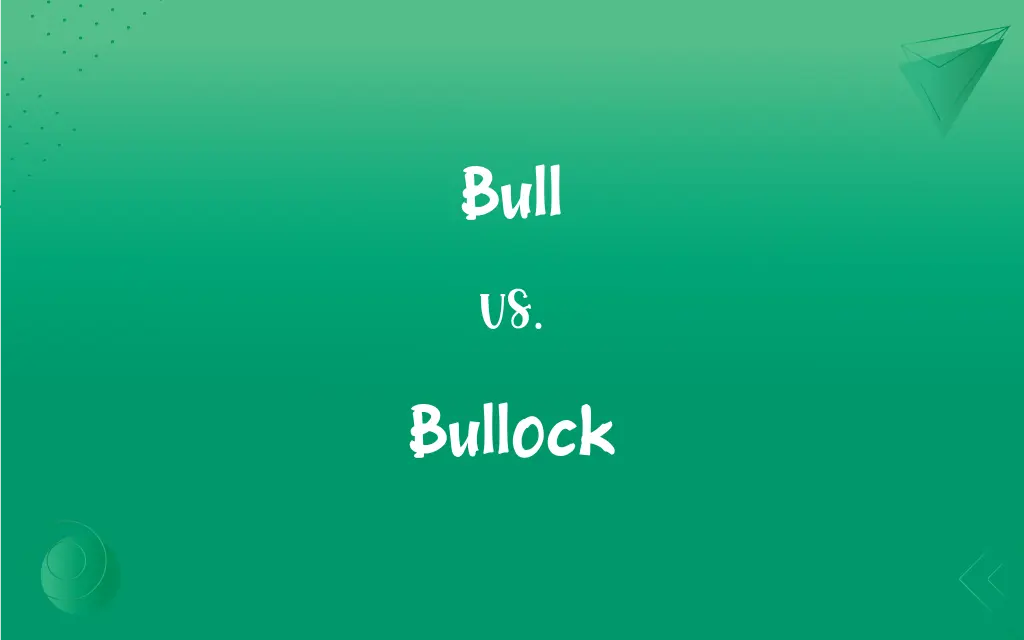Bull vs. Bullock: What's the Difference?
By Janet White & Harlon Moss || Updated on June 12, 2024
A bull is a mature male of the species Bos taurus, known for its role in breeding and its presence in various cultural symbolisms. A bullock in British English, refers to a young male cattle that has been castrated and is often raised for meat.

Key Differences
Bulls are uncastrated male cattle known for their larger size, strength, and aggressive behavior, which can be attributed to their high levels of testosterone. Bulls are primarily kept for breeding purposes, contributing to the genetics of a herd. Due to their aggressive nature, bulls require careful handling and management. Bullocks, on the other hand, are castrated male cattle. The process of castration leads to a reduction in aggressive behavior, making them more docile and easier to manage. This docility is particularly valued in situations where cattle are used as draft animals, pulling plows or carts.
The main difference between a bull and a bullock lies in their reproductive capabilities and the roles they play within cattle management. Bulls contribute to breeding and the genetic diversity of the species, while bullocks are utilized for their labor and meat, benefiting from the behavioral changes that castration induces.
Comparison Chart
Definition
An uncastrated male cattle, kept for breeding purposes
A castrated male cattle, often raised for meat or used as a draft animal
Characteristics
Larger size, more aggressive behavior
More docile and easier to manage due to castration
Primary Use
Breeding and genetic improvement of herds
Meat production or as draft animals due to their docility
ADVERTISEMENT
Symbolism
Often symbolizes strength, power, and fertility in various cultures
Less commonly symbolized; focused more on utility in agriculture
Management
Requires careful handling due to aggressive behavior
Easier to manage and work with because of reduced aggression
Bull and Bullock Definitions
Bull
Contributes to herd diversity.
Selectively breeding bulls with cows enhances the herd's qualities.
Bullock
A young, castrated male cattle, often raised for beef.
The bullocks were grazing peacefully in the pasture.
Bull
A mature, uncastrated male cattle used for breeding.
The farmer purchased a new bull to improve the herd's genetics.
ADVERTISEMENT
Bullock
Preferred for meat production.
The bullock was raised to a specific weight before being sold for meat.
Bull
Symbol of fertility in many cultures.
In ancient mythology, the bull was often associated with fertility gods.
Bullock
More docile than bulls.
After castration, the young bullocks became much easier to manage.
Bull
Known for aggressive behavior and strength.
The bull in the field charged at the fence when approached.
Bullock
Does not engage in breeding.
Bullocks are castrated to prevent breeding and to ensure docility for agricultural work.
Bull
Requires experienced handling.
Handling bulls requires knowledge and caution due to their unpredictable nature.
Bullock
A castrated bull; a steer.
Bullock
A young bull.
Bullock
A castrated bull; an ox.
Bullock
To bully.
Bullock
A young bull, or any male of the ox kind.
Take thy father's young bullock, even the second bullock of seven years old.
Bullock
An ox, steer, or stag.
Bullock
To bully.
She shan't think to bullock and domineer over me.
Bullock
Young bull
Bullock
Castrated bull
Bullock
Used as draft animals in some cultures.
Bullocks pull carts and plows in traditional farming communities.
FAQs
Why are bulls castrated to become bullocks?
Bulls are castrated to create bullocks, reducing aggressive behavior and making them easier to manage for meat production or as draft animals.
How does castration affect meat quality in bullocks?
Castration is believed to improve meat quality, making it more tender and flavorful, as it prevents the development of certain characteristics associated with uncastrated males.
How do farmers decide whether to keep a bull or castrate it to become a bullock?
The decision is based on the animal's intended use, with potential breeding bulls kept intact for genetic contributions, while those destined for meat production or draft work are often castrated.
What is the lifespan difference between a bull and a bullock?
The lifespan of bulls and bullocks can be similar; however, it often depends more on their use (breeding, work, or meat production) than on the differences between being castrated or not. Bulls used for breeding might have a managed lifespan based on their productivity, while bullocks raised for meat may have shorter lifespans due to early harvesting.
Can all male cattle become either a bull or a bullock?
Yes, all male cattle can remain bulls if left uncastrated or become bullocks through castration, with the choice depending on their intended role in agriculture.
Do bulls and bullocks require different types of feed?
Both bulls and bullocks can be raised on similar diets, but bulls might require higher protein or energy-dense feed to support their larger size and muscle development, especially if they are actively breeding. Bullocks, being raised for meat or work, might be on a diet optimized for growth efficiency and meat quality.
How does the introduction of a bull or bullock affect the dynamics of a cattle herd?
Introducing a bull into a herd can affect dynamics significantly, especially during breeding seasons, as it may increase competition and aggression among males. Introducing bullocks, being more docile, typically has less impact on herd dynamics and can integrate more smoothly.
Can bullocks still grow to the same size as bulls?
While bullocks can grow large, they typically do not reach the same size or muscular development as uncastrated bulls, partly due to differences in hormone levels.
Can the behavior of a bull change after castration?
Yes, castration significantly reduces aggressive behavior and sexual activity in bulls, making them more docile and easier to manage, which is why they are then referred to as bullocks.
Are bullocks used in rodeos or bullfighting?
No, bullocks are not typically used in rodeos or bullfighting; these activities usually involve uncastrated bulls, which display the aggressive behavior sought for these events.
Is there a difference in the care requirements between bulls and bullocks?
Yes, bulls require more careful handling due to their aggression and strength, while bullocks, being more docile, are easier to manage on a daily basis.
How do cultural or religious beliefs influence the perception and treatment of bulls and bullocks?
Cultural and religious beliefs can significantly influence how bulls and bullocks are perceived and treated, with bulls often revered in certain cultures for their symbolic significance, affecting their use in ceremonies or as work animals. In contrast, bullocks may be viewed primarily as agricultural assets.
How do market demands affect the raising and utilization of bulls and bullocks?
Market demands for beef, dairy products, and breeding stock directly affect how bulls and bullocks are raised and utilized, with market trends and consumer preferences influencing everything from breeding decisions to meat production practices.
What are the environmental impacts of raising bulls compared to bullocks?
The environmental impacts are somewhat similar, but since bulls are typically fewer in number within a herd and managed for breeding, their specific impact per animal might be higher due to their larger size and feed requirements. Bullocks, raised in larger numbers for meat, contribute to environmental concerns related to livestock, such as methane emissions and land use.
What advancements in veterinary care have impacted the health and management of bulls and bullocks?
Advancements in veterinary care, including better nutrition, disease management, and reproductive technologies, have improved the health, longevity, and productivity of both bulls and bullocks, enhancing their welfare and economic value.
How do weather and climate affect bulls and bullocks differently?
Weather and climate impacts are generally similar for bulls and bullocks, as both require adequate shelter, water, and management to ensure health. However, bulls might experience more stress in extreme conditions due to their larger size and higher metabolic rates.
Are there specific breeds where bulls are not castrated to become bullocks?
Most male cattle in beef production are castrated to become bullocks, but the decision can vary based on breed characteristics, intended use, and management practices. Some breeds may be more commonly kept as bulls for longer periods due to their temperaments or specific breed qualities.
What are the ethical considerations in deciding to castrate a bull to create a bullock?
Ethical considerations include animal welfare, the necessity of castration for management and meat quality purposes, and the use of pain management techniques during castration to minimize distress.
How has technology influenced the breeding, management, and production of bulls and bullocks?
Technology, including artificial insemination, genetic testing, and precision agriculture tools, has revolutionized the breeding, management, and production of bulls and bullocks, allowing for more efficient and targeted approaches to livestock farming.
What legal or regulatory considerations affect the management of bulls and bullocks?
Legal and regulatory considerations may include welfare standards, transportation requirements, and slaughter regulations, which aim to ensure the humane treatment of all livestock, including bulls and bullocks. Specific regulations might also govern the use of bulls in breeding programs.
About Author
Written by
Janet WhiteJanet White has been an esteemed writer and blogger for Difference Wiki. Holding a Master's degree in Science and Medical Journalism from the prestigious Boston University, she has consistently demonstrated her expertise and passion for her field. When she's not immersed in her work, Janet relishes her time exercising, delving into a good book, and cherishing moments with friends and family.
Co-written by
Harlon MossHarlon is a seasoned quality moderator and accomplished content writer for Difference Wiki. An alumnus of the prestigious University of California, he earned his degree in Computer Science. Leveraging his academic background, Harlon brings a meticulous and informed perspective to his work, ensuring content accuracy and excellence.































































